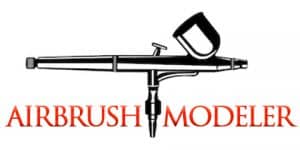
What Is A Side Feed Airbrush
A side feed airbrush has the paint cup positioned directly to the side of the airbrush body, as opposed to a siphon feed which hangs the paint jar below the airbrush, and a gravity feed which sits the paint cup on top of the airbrush.
Technically though, you could say that the side feed airbrush is both siphon feed AND gravity feed all at once.
Don’t let this confuse you, it’s simply a matter of the orientation of the airbrush while it’s being used.
Here’s how it works…
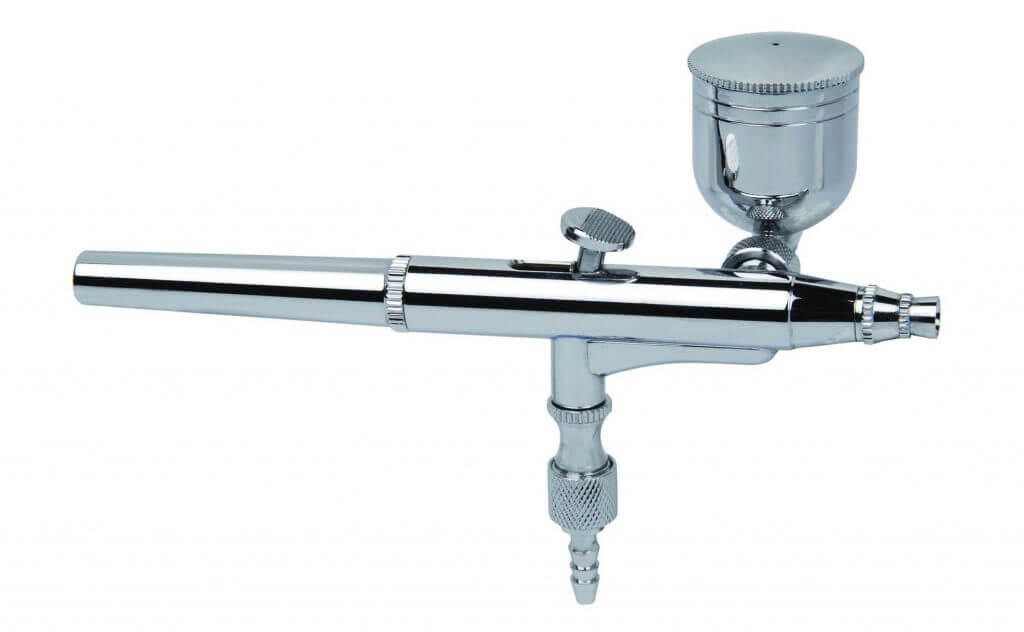
How Does A Side Feed Airbrush Work
To state the obvious, the paint sits in the airbrush cup mounted on the side ready for use.
If the paint level in the cup is above the level of the airbrush nozzle, that is, the point that the paint exits the airbrush, then the airbrush is working as a gravity feed.
This is because the paint exits the airbrush as a level which is below the paint level in the cup and this allows gravity to assist it down.
On the other hand, if the paint level in the cup is below the airbrush nozzle where the paint exits, then the paint has to work against gravity to get up to the nozzle and so the airbrush is then considered to be acting as a siphon feed.
The ability of a side feed airbrush to handle both siphon feed and gravity feed scenarios makes it quite versatile in terms of the paint cups that you can use, and also the unusual orientations that their airbrush can be used in.
Let’s take a look at some of these advantages in detail plus a whole lot more…
Advantages Of A Side Feed Airbrush
We just mentioned that various different paint cup types can be used with a side feed airbrush so let’s start there…
Paint Cup Choices
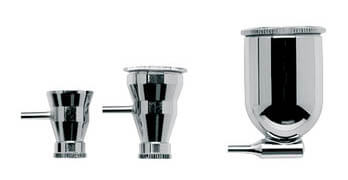
With a side feed airbrush you have the choice of a larger cup that connects to the side of the airbrush but then hangs low, and a smaller cup that also connects to the side of the airbrush but the connection is at the bottom of the paint cup and so it sits a little higher than the airbrush body.
The low hanging larger paint cups are great for when you have large areas to paint and need to use a greater volume of paint that these cups usually allow for.
If you only require a small amount of paint then the smaller cups that sit a little higher are excellent as they’re bulky, lighter, and tend to get in the way less.
Fast Colour Changes
As you may have already guessed, what with us talking about different cup types, cups can usually be swapped around on a side feed airbrush very easily.
This means you can do very fast colour changes in lower hanging cups that are already pre-mixed with paint and thinners, or even with the higher sitting cups that don’t need cleaning straight away.
All you need to do is flush out the airbrush with thinners or cleaner, attach the new cup, and you’re good to go!
Cleaning… Soaking Cups
As the cups are often easily removable they are usually quite easy to clean.
This can not always be said for a gravity feed airbrush with a built in paint cup which, while not being problematic, it can take a little more time.Many airbrush users who paint fine details find that a gravity feed airbrush with the paint cup perched right on top sometimes gets in their field of vision and causes problems focusing properly on their paint work.
A side feed airbrush gets around this problem by taking the cup away from the top of the airbrush entirely and positions it to the side where it’s almost entirely out of view.👍
Can Airbrush At Any Angle
Pointing the airbrush straight up or straight down is no problem at all, as the cup on the side the be turned and positioned such that the paint won’t spill out when you move the airbrush to extreme angles.
This may not be of any benefit to some, especially if all you do it airbrush plastic models and the like, but if you have a project that requires some crazy airbrushing angles then the side feed airbrush is the item to have. 👊
Disadvantages Of A Side Feed Airbrush
There are some potential drawbacks of using a side feed airbrush, and although they may be minor issues to many it’s worth covering them off none the less…
Possibility Of Higher psi Requirements
All other things being equal, a siphon feed airbrush will require more air pressure to properly atomise the paint than a gravity feed, however a side feed is both types so where does that put it?
Again, all other things being equal, a side feed airbrush falls in the middle for the most part, needing either a small amount of additional pressure if it’s acting like a gravity feed or a reasonable amount of additional pressure if it’s acting like a siphon feed.
The problem with additional pressure requirements comes in when you need to do fine detail work which necessitates the lowest air pressure possible.
A good quality side feed airbrush will still be able to manage fine detail work exceptionally well, however perhaps not as well as a gravity feed airbrush that can operate perfectly at a lower working air pressure.
Possibility Of Additional Cleaning And More Challenging Cleaning
Side feed airbrush cups can have paint tubes that connect the cup to the airbrush which are hard to access and clean out properly.
To be fair, a good airbrush cleaner flush will often do the trick, and there are airbrush cleaning tools that will lend themselves very well to perfectly cleaning the paint tubes
But none the less it still bears mentioning as it can be a more time consuming task to clean a side feed airbrush than a gravity feed or certain types of siphon feed.
So now that we’ve covered off some of the pro’s and cons of side feed airbrushes, how do they generally stack up against siphon feed and gravity feed airbrushes…?
Side Feed Airbrush Vs Gravity Feed and Siphon Feed Airbrushes
At the end of the day the airbrush that works best for you often comes down to user preference in terms of how it feels generally and the overall perception of the tool, and people will often claim they prefer one style of airbrush over another just ‘because’.
But this being the case there are some good reasons you may choose a side feed airbrush over a siphon feed or gravity feed type…
Paint Cup Options
You can get large paint cups for extended airbrushing sessions over large areas, or small areas with smaller detail.
In this sense the side feed airbrush is definitely the most versatile type.
Quick Swapping Of Colours
Given the cups are quite easy to change on the fly you can have multiple colours ready to go extremely quickly, which helps if you’re in a rush or have a reason to change colours quickly (not that I can think of what that reason may be… 🙄)
Unrestricted View
With the cup out of the way to the side, a side feed airbrush can be superior with regards to not restricting vision and not banging the paint cup or jar on anything.
Additionally, side feed airbrushes often come in right and left handed versions so you can have a choice of whether you want the cup on the left or right hand side of the airbrush body.
If these factors aren’t really a consideration for you though then there’s no need to short list a particular airbrush just because it’s side feed.
In fact, here are some reasons you may prefer to avoid a side feed style airbrush altogether…
Cleaning Considerations
Depending on the setup of the side feed airbrush it may take a little longer and be a little more challenging to clean.
This is rarely a deal breaker though and I’m not talking a crazy amount of extra time, but it’s something to be aware of and consider when you’re looking for a new airbrush.
Possibly Restricted Detail Work
Owing to the higher minimum pressure available (to properly atomise the paint), on average, of a side feed airbrush, it will usually have less capability of doing fine detail work, all other things being equal.
On the flip side though, a purely siphon feed airbrush will have an even lower minimum pressure available (to properly atomise the paint) and so a side feed airbrush will tend to have better fine detail capability, again, all other things being equal
👍 On a related note, for more in-depth information on the pro’s and cons of gravity feed vs siphon feed airbrushes check out this detailed article.
Examples Of Side Feed Airbrushes
Below you’ll find some examples of side feed airbrushes from well known and reputable brands, plus links to review and current prices…
| Airbrush Brand/Model | Link To Reviews | |
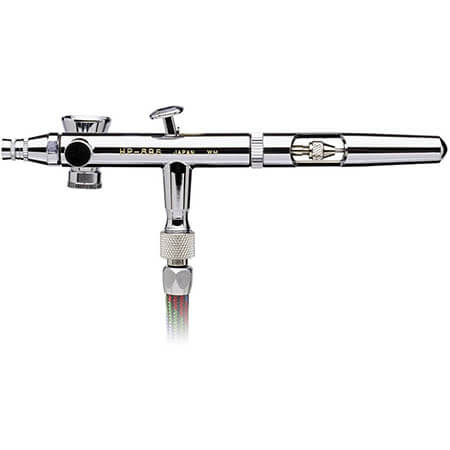 | Iwata Eclipse HP-SBS Side-Feed Dual-Action Airbrush | Click Here For Reviews & Current Prices |
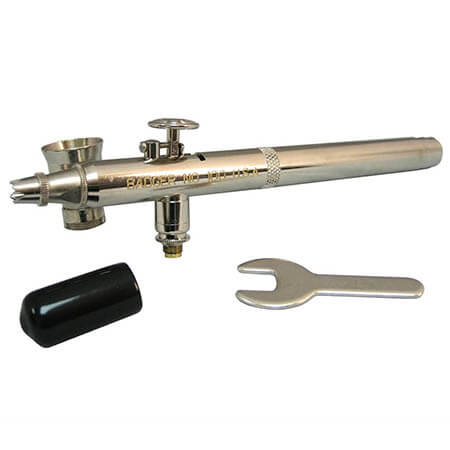 | Badger Model 100 Side-Feed | Click Here For Reviews & Current Prices |
At the end of the day side feed airbrushes will certainly hold their own with regards to overall capabilities and paintwork quality, although for whatever reason do tend to be harder to find that gravity feed or siphon feed models.
For me personally, I prefer gravity feed airbrushes largely because that’s what I’m used to, and I will always take a gravity feed over other airbrush types.
However if I had to choose between a siphon feed and side feed, it’s almost certain that I would go with a side feed.
But… that’s just me and my preferences, and you should look at each airbrushes features and see what matches your requirements rather than blindly go on what someone else says.
And if you do choose to invest in a side feed airbrush from a reputable brand that meets all of your requirements, you certainly won’t be let down. 👍
